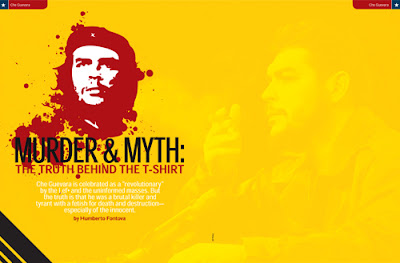Editor’s note: This exposé on Che Guevara first appeared in the June 2009 issue of Townhall Magazine. To subscribe to Townhall Magazine and get your free copy of “The Politically Incorrect Guide to the Constitution,” click here.

The U.K. Guardian interviewed Oscar-winning actor Benicio del Toro earlier this year regarding his role as Che Guevara in Stephen Soderbergh’s new movie “Che.” “Dammit This Guy Is Cool!” was the interview title. “Del Toro was fascinated with Che Guevara from the first time he heard his name mentioned in the Rolling Stones song ‘Indian Girl,’” reads the introduction to the interview. “I hear of this guy, and he’s got a cool name, Che Guevara!” says del Toro. “Groovy name, groovy man, groovy politics! So I came across a picture of Che, smiling, in fatigues, I thought, ‘Dammit, this guy is cool-looking!’”
Well, there you have it. In effect, Benicio del Toro, who fulfilled an obvious fantasy by starring as Che Guevara in the four-and-a-half-hour movie he also co-produced, revealed the inspiration (and daunting intellectual exertion) of millions of Che fans—and not only recent ones. “1968 actually began in 1967 with the murder of Che,” recounts Christopher Hitchens. “His death meant a lot to me, and countless like me, at the time. Che was a role model.”
Upon winning the Cannes Film Festival’s “best actor” award (Sean Penn headed the voting jury) for his “Che” role, del Toro dedicated the award “to the man himself, Che Guevara!” “Through all the awards the movie gets,” gushed del Toro during the award ceremony, “you’ll have to pay your respects to the man!”
DIG THIS
As a celebrity-hipster fan of Che Guevara, del Toro has plenty of company paying these respects. Johnny Depp conspicuously wears a Che pendant from his neck and in a Vibe magazine interview proclaimed his “digging” of Che Guevara.
The New York Times titled its review of Soderbergh’s movie, “Saluting the Rebel Underneath the T-Shirt.” In fact, had del Toro, Depp or Hitchens been born earlier and in Cuba and attempted a rebel lifestyle, their “digging” of Castroite Cuba would have been of a more literal nature. Del Toro, Depp and Hitchens would have found themselves chained and digging ditches and mass graves in a prison camp system inspired by the man they “dig.” Had their digging in a Cuban forced-labor camp lagged, a “groovy” Communist guard might have shattered their teeth with a “groovy” Czech machine-gun butt, or perhaps slashed their buttocks with some “groovy” Soviet bayonets.
In a famous speech in 1961, Che Guevara denounced the very “spirit of rebellion” as “reprehensible.” “Youth must refrain from ungrateful questioning of governmental mandates,” commanded Guevara. “Instead, they must dedicate themselves to study, work and military service.” “Youth,” wrote Guevara, “should learn to think and act as a mass.”
“Those who choose their own path” (as in growing long hair and listening to “Yankee-Imperialist” Rock & Roll) were denounced as worthless “roqueros,” “lumpen” and “delinquents.” In his famous speech, Che Guevara even vowed “to make individualism disappear from Cuba! It is criminal to think of individuals!”
Tens of thousands of Cuban youths learned that Che Guevara’s admonitions were more than idle bombast. In Guevara, the hundreds of Soviet KGB and East German STASI “consultants” who flooded Cuba in the early 1960s found an extremely eager acolyte. By the mid ’60s, the crime of a “rocker” lifestyle (blue jeans, long hair, fondness for the Beatles and Stones) or effeminate behavior got thousands of youths yanked out of Cuba’s streets and parks by secret police and dumped in prison camps with “Work Will Make Men Out of You” emblazoned in bold letters above the gate and with machine gunners posted on the watchtowers. The initials for these camps were UMAP, not GULAG, but the conditions were quite similar.
Recommended
Today, the world’s largest image of the man that so many hipsters sport on their shirts adorns Cuba’s headquarters and torture chambers for its KGB-trained secret police. Nothing could be more fitting.
Ignorance, of course, accounts for much Che idolatry. But so does mendacity and wishful thinking, all of it boosted by reflexive anti-Americanism. The most popular version of the Che T-shirt, for instance, sports the slogan “fight oppression” under his famous countenance. This is the face of the second in command, chief executioner and chief KGB liaison for a regime that jailed political prisoners at a higher rate than Stalin’s and executed more people in its first three years in power than Hitler’s executed in its first six.
THE REAL OPPRESSOR
In 1959, Cuba had a population of 6.4 million people (with a higher per capita income than most Europeans, by the way). According to Freedom House, 500,000 Cubans have passed through Cuba’s prison systems, proportionally more than went through Stalin’s Gulag. And many of Che Guevara’s political prisoners qualify as the longest-suffering political prisoners in modern history, having suffered prison camps, forced labor and torture chambers for a period three times as long in Fidel and Che’s Gulag as Alexander Solzhenitsyn suffered in Stalin’s.
The figures for the Che/Castro murders and jailings do not come from any “biased” Cuban-exile source. They’re available from “The Black Book of Communism,” authored by French scholars and translated into English by Harvard University Press, not exactly headquarters for any vast right-wing conspiracy.
In 1956-7, this world-famous “Anti-Imperialist” who often signed his personal correspondence with the moniker “Stalin II,” appalled some of his fellow anti-Batista rebels by applauding the Soviet slaughter of Hungarian freedom fighters. All through the horrifying Soviet massacre, Che dutifully parroted the Soviet script that the workers, peasants and college kids battling Russian tanks in Budapest with small arms and Molotov cocktails were all “Fascists and CIA agents!” who all deserved prompt execution.
“Executions?” Che Guevara exclaimed while addressing the hallowed halls of the U.N. General Assembly Dec. 9, 1964. “Certainly we execute!” he declared, to the claps and cheers of that august body. “And we will continue executing as long as it is necessary! This is a war to the death against the revolution’s enemies!”
According to the “Black Book of Communism,” those firing-squad executions had reached 14,000 by the end of the ’60s, the equivalent, given the relative populations, of more than 3 million executions in the U.S. “I don’t need proof to execute a man,” snapped Che to a judicial toady in 1959. “I only need proof that it’s necessary to execute him! … Judicial evidence is an archaic bourgeois detail. We execute from revolutionary conviction.”
Upon arriving in Havana in January 1959 after an utterly bogus guerrilla war (The New York Times breathlessly reported of “thousands dead in single battles!” The official tally compiled by the U.S. embassy after two years of ferocious “civil war” was 184 dead on both sides, half New Orleans’ annual murder tally.), Che Guevara immediately recognized the moat around Havana’s old Spanish fortress La Cabana as a handy-dandy, ready-made execution pit. So he promptly put his firing squads to work in triple shifts.
Edwin Tetlow, Havana correspondent for London’s Daily Telegraph, reported on a mass “trial” orchestrated by Che Guevara in February 1959, where Tetlow noticed the death sentences posted on a board before the trial had started.
“When you saw the beaming look on Che’s face as the victims were tied to the stake and blasted apart by the firing squad,” former Cuban political prisoner, Roberto Martin-Perez, told me, “you saw there was something seriously, seriously wrong with Che Guevara.”
“Castro ordered mass murder,” remembers Martin-Perez, “but for him it was a utilitarian slaughter, in order to consolidate his power. A classic psychopath, the butchery didn’t seem to affect him one way or the order. But Che Guevara, as his chief executioner, relished the slaughter.”
As commander of this prison/execution yard, Che often shattered the skull of the condemned man by firing the coup de grace himself. When other duties tore him away from his beloved execution yard, he consoled himself by viewing the slaughter. Che’s second-story office in La Cabana had a section of wall torn out so he could watch his darling firing squads at work.
A Romanian journalist named Stefan Bacie visited Cuba in early 1959 and was fortunate enough to get an audience with the already famous Che Guevara. Upon entering the chief executioner’s office, Bacie saw Che motioning him over to the office’s newly constructed window. Bacie got there just in time to hear the command of “Fuego!,” hear the blast from the firing squad and see a condemned prisoner man crumple and convulse. The stricken journalist immediately left and composed a poem, titled, “I No Longer Sing of Che.” (“I no longer sing of Che, any more than I would of Stalin,” go the first lines.)

WOMEN AND CHILDREN, TOO
Even as a youth, Ernesto “Che” Guevara’s writings revealed a serious mental illness. “My nostrils dilate while savoring the acrid odor of gunpowder and blood. Crazy with fury I will stain my rifle red while slaughtering any vencido that falls in my hands! With the deaths of my enemies I prepare my being for the sacred fight and join the triumphant proletariat with a bestial howl!” This is from Guevara’s famous “Motorcycle Diaries,” though Robert Redford somehow “overlooked” it while directing his heartwarming movie of the same name.
The Spanish word vencido, by the way, translates into “defeated” or “surrendered.” And indeed, “the “acrid odor of gunpowder and blood” very rarely reached Guevara’s nostrils from actual combat. It came mostly from the close-range murders of unarmed and defenseless men (and boys). Carlos Machado was 15 years old in 1963 when the bullets from the fi ring squad shattered his body. His twin brother and father collapsed beside Carlos from the same volley. All had resisted Castro’s and Che’s theft of their humble family farm.
Rigoberto Hernandez was 17 when Che’s soldiers dragged him from his cell in La Cabana, jerked his head back to gag him and started dragging him to the stake. Little “Rigo” pleaded his innocence to the very bloody end. But his pleas were garbled and difficult to understand. His struggles while being gagged and bound to the stake were also awkward. The boy had been a janitor in a Havana high school and was mentally retarded. His single mother had pleaded his case with hysterical sobs. She had begged, beseeched and finally proven to his “prosecutors” that it was a case of mistaken identity. Her only son, a boy in such a condition, couldn’t possibly have been “a CIA agent planting bombs.”
“Fuego!” and the firing squad volley riddled Rigo’s little bent body as he moaned and struggled awkwardly against his bounds, blindfold and gag. Remember the gallant Che Guevara’s instructions to his revolutionary courts: “Judicial evidence is an archaic bourgeois detail.” And remember that Harvard Law School’s invitation to Fidel Castro to speak on campus, and rollicking ovation he received, happened in the very midst of this appalling and lawless bloodbath.
The victims of this Stalinist bloodbath were not exclusively men and boys. In fact, the Castroites were well ahead of the Taliban. On Christmas Eve 1961, a young Cuban woman named Juana Diaz spat in the face of the executioners who were binding and gagging her. They’d found her guilty of feeding and hiding “bandits” (Che’s term for Cuban rednecks who took up arms to fight his theft of their land to create Stalinist kolkhozes). When the blast from that firing squad demolished her face and torso, Juana was six months pregnant.
The term “hatred” was a constant in Guevara’s writings. Here’s a taste from this icon of flower children: “Hatred as an element of struggle”; “hatred that is intransigent”; “hatred so violent that it propels a human being beyond his natural limitations, making him a violent and cold-blooded killing machine.”
A RECORD OF FAILURE
The one genuine accomplishment in Che Guevara’s life was the mass-murder of defenseless men and boys. Under his own gun, dozens died. Under his orders, thousands crumpled. At everything else Che Guevara failed abysmally, even comically. In 1965, while planning a military campaign in the Congo against crack mercenaries commanded by a professional soldier who helped defeat Rommel in North Africa, Che confidently allied himself with “soldiers” who used chicken feathers for helmets and stood in the open waving at attacking aircraft because a muganga (witch doctor) had assured them that the magic water he sprinkled over them would make .50 caliber bullets bounce harmlessly off their bodies. Six months later, Che fled Africa, narrowly escaping with his life and with his tail tucked tightly between his legs.
Two years later, during his Bolivian “guerrilla” campaign, Che split his forces, whereupon they got hopelessly lost and bumbled around, half-starved, half-clothed and half-shod, without any contact with each other for six months before being wiped out. They didn’t even have World War II vintage walkie-talkies to communicate and seemed incapable of applying a compass reading to a map. They spent much of the time walking in circles and were usually within a mile of each other. During this blundering, they often engaged in ferocious firefights against each other.
“You hate to laugh at anything associated with Che, who murdered so many,” says Felix Rodriguez, the Cuban- American CIA officer who played a key role in tracking Guevara down in Bolivia. “But when it comes to Che as ‘guerrilla,’ you simply can’t help but guffaw.”
DREAMS OF DESTRUCTION
Che’s genocidal fantasies included a continental reign of Stalinism. And to achieve this ideal, he craved “millions of atomic victims”—most of them Americans. “The U.S. is the great enemy of mankind!” raved Guevara in 1961. “Against those hyenas there is no option but extermination. We will bring the war to the imperialist enemies’ very home, to his places of work and recreation. The imperialist enemy must feel like a hunted animal wherever he moves. Thus, we’ll destroy him! We must keep our hatred against them [the U.S.] alive and fan it to paroxysms!”
This was Che’s prescription for America almost a half-century before Osama bin Laden, Mullah Omar and Al- Zarqawi appeared on our radar screens. Compared to Che Guevara, Ahmadinejad sounds like the Dalai Lama.
On Nov. 17, 1962, J. Edgar Hoover’s FBI discovered that Che Guevara’s bombast had substance. They infiltrated and cracked a plot by Cuban agents that targeted Macy’s, Gimbel’s, Bloomingdale’s and Manhattan’s Grand Central Terminal with a dozen incendiary devices and 500 kilos of TNT. The holocaust was set to go off the following week, the day after Thanksgiving. Che Guevara was the head of Cuba’s “Foreign Liberation Department” at the time.
A little perspective: For the March 2004 Madrid subway blasts, all 10 of them that killed and maimed almost 2,000 people, al Qaeda used a grand total of 100 kilos of TNT. Castro’s and Che’s agents planned to set off five times that explosive power in some of the biggest department stores on earth, all packed to suffocation and pulsing with holiday cheer on the year’s biggest shopping day. Thousands of New Yorkers, including women and children—actually, given the date and targets, probably mostly women and children—were to be incinerated and entombed.
A month earlier (during what came to be known as the Cuban Missile Crisis), Fidel Castro and Che Guevara had salivated over the prospect of a much more satisfying holocaust. “If the nuclear missiles had remained, we would have fired them against the heart of the U.S., including New York City,” boasted Guevara in November 1962. “The victory of socialism is well worth millions of atomic victims.” Che thought he was speaking “off-the-record” to Sam Russell of Britain’s Daily Worker at the time.
But for the prudence of Nikita Khrushchev, the Butcher of Budapest, those “millions of atomic victims” might have come about. Despite the diligent work of Kennedy Camelot court scribes and their ever-eager acolytes in the mainstream media, publishing and Hollywood, many serious analysts conclude that Fidel’s and Che’s genocidal fantasy was a much bigger factor in Khrushchev’s decision to yank the missiles from Cuba than President Kennedy’s utterly bogus bluster, threats and “blockade.”
AMERICAN MEDIA AND THE MAKING OF AN ICON
So for many, the question remains: How did such an incurable doofus, sadist and epic idiot attain such iconic status?
The answer is that this psychotic and thoroughly unimposing vagrant named Ernesto Guevara de la Serna y Lynch had the magnificent fortune of linking up with modern history’s top press agent, Fidel Castro, who—from The New York Times’ Herbert Matthews in 1957 through CBS’ Ed Murrow in 1959 to CBS’ Dan Rather to ABC’s Barbara Walters to NBC’s Andrea Mitchell, more recently—always had the mainstream media anxiously scurrying to his every beck and call and eating out of his hand like trained pigeons.
Had Guevara not linked up with Raul and Fidel Castro in Mexico City that fateful summer of 1955—had he not linked up with a Cuban exile named Nico Lopez in Guatemala the year before who later introduced him to Raul and Fidel Castro in Mexico City—everything points to Ernesto continuing his life of a traveling hobo, panhandling, mooching off women, staying in flophouses and scribbling unreadable poetry.
Not to be outdone in the trained-pigeon department, while making their new film, Steven Soderbergh and Benicio del Toro repeatedly visited Havana to coo and peck away as anxiously as those newsmen while the regime tossed out its propaganda crumbs. Indeed, Soderbergh’s very screenplay is based on Che Guevara’s diaries, published in Havana with the foreword written by Fidel Castro himself.
“‘Che’ Film Gets Thumbs up in Cuba,” ran the headline from CNN’s Havana bureau on Dec. 8. Benicio del Toro had just introduced it in person as the highlight of the Havana Film Festival. “It’s a privilege to be here!” gushed del Toro to his Stalinist hosts. “I’m grateful that the Cuban people can see this movie!”
And why shouldn’t Castro’s subjects be allowed to view his movie? Weren’t Stalin’s subjects allowed to watch “The Battleship Potemkin”? Weren’t Hitler’s subjects allowed to watch Leni Riefenstahl’s “Triumph of Will”? Both were produced at the direction of the propaganda ministries of totalitarian regimes—as was mostly the case with Soderbergh and del Toro’s “Che.” A proclamation from Castro’s own propaganda ministry dated Dec. 7, 2008, actually boasts of their role: “Actor Benicio del Toro presented the film (at Havana’s Karl Marx Theater) as he thanked the Cuban Film Institute (ICAIC) for its assistance during the shooting of the film, which was the result of seven-year research work in Cuba” (emphasis added). The ICAIC is an arm of Stalinist Cuba’s propaganda ministry.
More than his sadism, megalomania or even his epic stupidity, what most distinguished Ernesto “Che” Guevara from his peers was his sniveling cowardice. In 1967, Che learned that taking on Fidel Castro as agent has its drawbacks. As many of his former colleagues all attest, “Fidel only praises the dead.” So prior to whooping up his revolutionary sidekick, Fidel Castro sent him “to sleep with the fishes.”
Too bad Soderbergh and del Toro didn’t interview the former CIA officers who revealed to me in interviews how Fidel Castro himself, via the Bolivian Communist Party, constantly fed the CIA info on Che’s whereabouts in Bolivia. Including Fidel Castro’s directive to the Bolivian Communists regarding Che and his merry band might have also added drama to their film. “Not even an aspirin,” instructed Cuba’s Maximum Leader to his Bolivian comrades, meaning that Bolivia’s Communists were not to assist Che in any way—“not even with an aspirin,” if Che complained of a headache.
One day before his death in Bolivia, Che Guevara—for the first time in his life—finally faced something properly describable as combat. So he ordered his guerrilla charges to give no quarter, to fight to their last breaths and to their last bullet. With his men doing exactly what he ordered (fighting and dying to the last bullet), a slightly wounded Che snuck away from the firefight and surrendered with fully loaded weapons while whimpering to his captors: “Don’t Shoot! I’m Che. I’m worth more to you alive than dead!” His Bolivian captors viewed the matter differently. In fact, they adopted a policy that has since become a favorite among Americans who encounter (so-called) endangered species threatening their families or livestock on their property: “Shoot, shovel and shut-up.”
Justice has never been better served.
























Join the conversation as a VIP Member